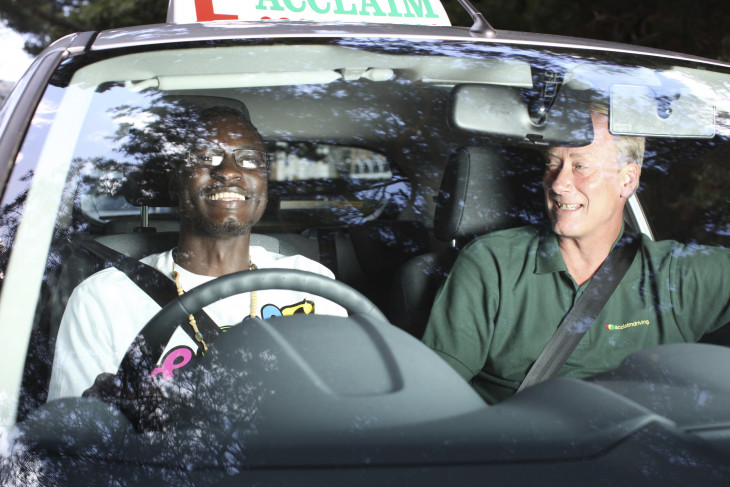By The Acclaim Team on 16th December 2020 in News
Driving tests are super easy, however, with many UK learners lacking confidence in their driving skills and unfortunately, failing their test due to driving test nerves.
It’s important to understand that we all make mistakes, and in the unlikely event that you do unfortunately fail your driving test, we will dedicate our time and efforts into making sure these errors are patched up in time for your driving test retake.
Before taking your driving test, it’s crucial to understand the common reasons for failing a driving test so that you can try your hardest to avoid making the same mistakes. Here are just a few of the most common driving test failures in the UK.
Lack of Observation
To become a good driver, you must be observant on the road. Unfortunately, one of the number one reasons for road accidents is drivers pulling out from junctions without looking and observing properly.
Lack of observation is one of the top reasons that learners fail their driving test, caused by failing to look properly at junctions before pulling out. It’s critical to analyse your surroundings properly to keep an eye out for pedestrians, cyclists or other drivers on the road. You should only proceed to pull out when it is safe to do so.
Not Using Mirrors Effectively
Linking back to observation, using your mirrors effectively can support in observing what is around the vehicle. Every manoeuvre relies on constant use of your three mirrors, so it’s absolutely vital you use them properly.
During your driving test, your examiner will be watching out for you checking your mirrors every time you set off, brake, change direction, change lanes or negotiate a hazard. Even if there are no cars behind you, if you fail to check your mirrors before braking, the examiner will have to fail you.
Inappropriate Speed
As obvious as it may seem, inappropriate speeds in your driving test can result in an instant failure. Driving too slow can be a huge danger if there are vehicles needing to overtake you, so you may land with a driving test fail if you’re driving too below the speed limit.
In your driving test, you must drive at the correct speed otherwise your examiner may assume that you are unaware of the speed limit. Be careful to not exceed the speed limit at any time as this will result in a fail and potentially land you with points on your licence before you even get a chance to gain your UK driving licence.
Incorrect Positioning
In order to be seen by other motorists and to get the best view on the road, you must position yourself correctly. Particularly in lanes and when approaching turns or roundabouts, you must position in advance to avoid creating hazards for other road users.
If your actions result in another driver to harshly brake or swerve to avoid a collision, you’ll find yourself with an instant fail. Keep a safe distance from other drivers and ensure the correct position for the route you’re taking. This also means that you should stay in the middle of the lane rather than straddling between two lanes.
Moving Away Safely
When starting off or moving away, you should always check your mirrors and check over your shoulders for the blind spots first, as there may well be pedestrians or other motorists in your surroundings. Moving away safely generally catches out many learners, not because of lack of observation, but rather due to nerves from stalling (poor clutch control) or failing to signal the indicators.
As moving away is a crucial step in your driving test, it’s important to make sure you get it spot on every time by checking your mirrors, blind spots and indicating to alert other road users of your intentions.
Use of Signals
Mirror, signal, manoeuvre. If you fail to signal properly during your test, you will unfortunately fail. Using signals is important in making other drivers aware of your intentions so they know when you are planning to merge onto the road, change lanes or begin to brake.
As well as signalling properly, it’s also important to know when to signal, as you may find yourself with a minor (or even a fail) if you indicate too early or late.
Steering Control
Believe it or not, steering control is another common reason for failing the DVSA driving test. As the driving test is an opportunity for you to prove you can drive and have full control when behind the wheel, if, when steering, you lose control of the steering wheel, you’ll end up with an instant fail.
Avoid crossing your hands when steering and be sure to grip the steering wheel firmly. Try to keep both hands on the steering wheel as much as possible and keep gear changes quick and brief.
Road Markings
Road markings are in place to maintain the control of traffic and to enable the safety of road users and pedestrians, whether it be stop lines, give way signs, parking restriction lines or broken white lines on a carriageway.
Not only is it important to know and understand road markings in a test in order to pass, it’s also imperative to know these road markings for real-life situations to avoid collisions or unnecessary fines.
Reverse Parking
Arguably the easiest way to park for many drivers, reverse parking will most likely be a manoeuvre you will carry out in your driving test.
Reverse parking takes a lot of observation, steering wheel control and patience, which you will need to demonstrate in your test. Some drivers struggle with this manoeuvre due to poor observation and lack of practice, which may land you with a fail if you need to reposition due to a complete misjudgement or loss of control.
Turn in the Road
A slightly less common fail is the turn in the road, which requires a smooth three-point turn on a narrow road. Though this isn’t always on every driving test, it still catches very few drivers out.
The turn in the road must be smooth and require as minimal turns as possible while paying close attention to your surroundings. Unfortunately, many learners panic and take the manoeuvre too fast under pressure and can even bump into the kerb if they aren’t careful. The key is to take the manoeuvre slowly and not panic if cars or pedestrians are around you. A smooth turn in the road requires constant checking of mirrors and blind spots.
Putting Other Drivers at Risk
It goes without saying, if you do anything to put other drivers at risk when driving, you will instantly fail your driving test. This includes your actions forcing another driver to swerve, excessively brake or becoming involved in a collision, as well as your own car coming into a collision.
With awareness of surroundings, constant checking of mirrors and blind spots, knowledge of speed and road signs, and consideration for other drivers, accidents can easily be avoided and other drivers won’t be put at risk.
Pass Your Driving Test With Acclaim Driving
Here at Acclaim Driving, we are always here to help with your driving test needs. At Acclaim Driving, we ensure that you have the confidence and self-belief in passing your DVSA driving test with flying colours. We take the time to make sure that you feel comfortable carrying out every manoeuvre.
Be sure to contact us, or reach out on 0800 838 440 if you have any questions about passing your driving test.




